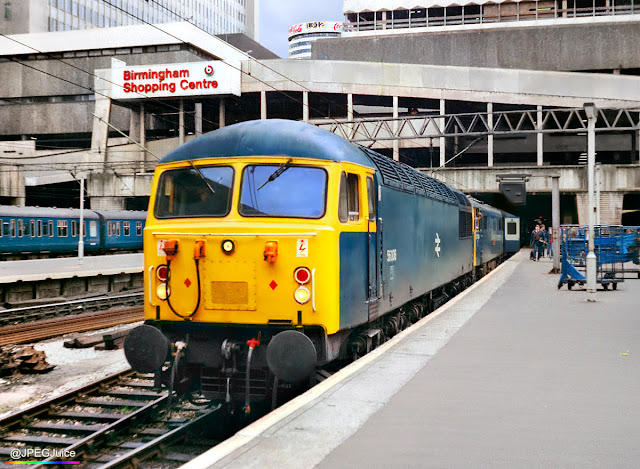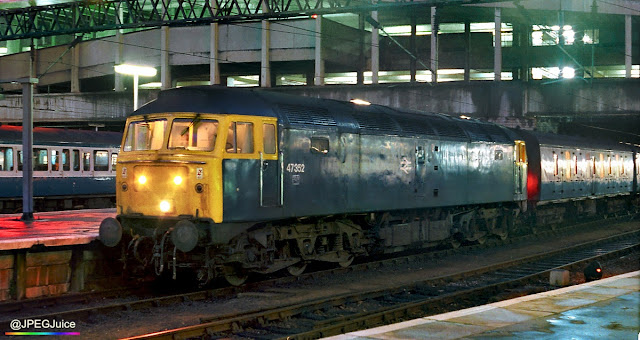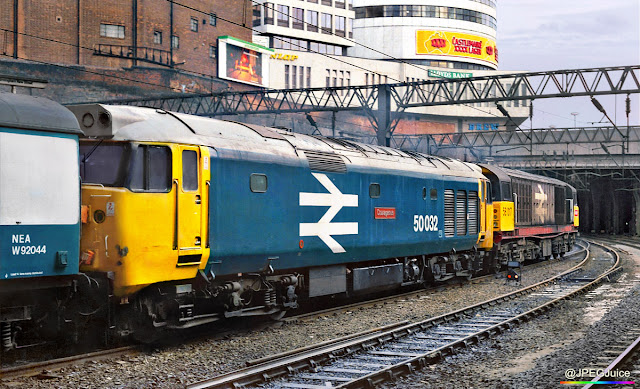"At the start of the 1980s, Saltley drivers were not passed to drive the Class 50s, so all WR-bound services crewed from Saltley were forced to use a Midland compatible loco."

Remember when Birmingham New Street station acted as a relentless conveyor belt of loco-hauled trains, diesel mechanical units, and 'dinosaur' EMUs? When Rail blue still ruled supreme? Well, in this post I'm going to recall that era with a selection of diesel-focused photographs taken between 1980 and 1986. Without further ado, let's hand over to an archaic Praktica LTL, Pentax P30, and cheaper-than-cheap Prinz compact, for a timehop back to the glory days...

Given the daily use of Class 37s on services between Birmingham and North Wales in the year 2000, it might come as a surprise to enthusiasts under the age of 40 that the type had no booked workings out of New Street twenty years earlier. In and around 1980, 'Syphon' fanatics would just have to keep their fingers crossed - probably for a long time. The photo above shows a reward for one such wait, in the shape of 37051, preparing to dep for a Sulzer Type 4 on the 10:20 to Swansea.
On summer Saturdays, 37s commonly appeared on the Birmingham - Scarborough or York - Tenby holiday trains, but beyond that, appearances were very hard to predict. If an example did turn up, it would most likely be standing in for a 'Peak' on a train to the North East, or down to South Wales. The 07:30 Birmingham - York was probably the best bet, but the train was booked for a 'Peak', and would usually get one.

After the rush hour, mail traffic kept New Street station busy, and in the mid 1980s, locomotive variety remained healthy. This is a 1984 shot of 'Skinhead' Class 31/1, No. 31129, shortly before it was selected for conversion to a 31/4. Although the Class 31s worked some postals, and randomly depped on Paddington services as well as some NE-SW trains, they were best known at New Street for their solid grip on the Birmingham - Norwich route.

Until the early 1980s, the 'Peaks' were absolutely core to NE-SW workings, and also commonly appeared on westbound CrossCountry journeys which switched from electric to diesel power at New Street. On CrossCountry, the 'Peak' may only get as far as Gloucester before being replaced by a 50 or a WR 47. That said, the 'Peaks' certainly had a presence in the West Country, and until the start of the decade, Plymouth Laira shared the allocation of the Class 46s with Gateshead. You can find picture-rich posts on later CrossCountry ops in the InterCity CrossCountry post, The Voyager Introduction Story, The CrossCountry HSTs, and The CrossCountry 47/8 Finale.
In 1980 the 45s were still mainly shared between Toton and Tinsley, with a handful based at Cricklewood. But by the time of the above 1986 photo of 45126 at rest with a postal, the 46s had completely left the scene, and all remaining Class 45s were allocated to Toton.

Sundays at New Street in the late 1970s and early 1980s, were often very boring days, but could go to the other extreme when a section of electric power was switched out for maintenance work. Outages between Birmingham and the North West could result in Class 40 appearances, which were exciting because, similarly to the 37s, the 40s had no booked workings out of New Street. But the absolute pinnacle of excitement would come when power was down on the Euston line, and a Class 56 was summoned to 'drag' a dead electric to or from Nuneaton.
The great majority of Euston 'drags' were performed by Class 47s, but alternatives could be substituted, including sub-Type 4 classes such as the 37s. And from around the start of the 1980s, a trend for occasional Class 56s began to gather some momentum. In the photo above, Romanian-built 56006 has hauled in 87004 Britannia and train on Sunday 21st June 1981.

The humble Brush Type 4 not only held an unshakeable monopoly on some services, but also depped for more popular loco types - like the Class 50s on the few Paddington expresses not themselves scheduled for Class 47 power. Trains heading to or coming in from the South East were important for lo-budget haulage-seekers - especially us kids - because they stopped at stations within the West Midlands boundary. That rendered them the only perpetual source of diesel loco traction for anyone whose haulage moves were confined, by lack of additional funds, to the West Midlands Travelcard area.
Trains like the 15:20 Brighton - Manchester (seen above in the care of no-heat 47352), and the 19:25 Birmingham - Didcot, sat at the centre of a 'Travelcard basher's activity in the early 1980s. Whilst these duties were wall-to-wall with Class 47s, they did somewhat diverge from the monotony of the Bescot and Old Oak Common 47/4s found on the majority of the Paddingtons.

At the start of the 1980s, Saltley drivers were not passed to drive the Class 50s, so all WR-bound services crewed from Saltley were forced to use a Midland compatible loco. But by the time of the above shot of 50021 Rodney in 1984, Saltley was familiar with the 'Hoovers', and they were a lot more welcome around Birmingham. At the end of the 1970s, train spotters would be lucky to see three 50s in a day at New Street, and incoming examples would be sent straight back to the WR with haste. But in '84 it would not be greatly surprising for BNS to witness six or seven of the large logo behemoths on a given day, and their allocation to services was very considerably looser.

Tyseley depot's diesel mechanical multiple units took care of the area's local routes. During the early '80s, Tyseley's staple design was the Class 116, as seen here on a Kidderminster service in 1984. In the early 'eighties Tyseley also looked after members of classes 100, 101, 104, 105, 117, 122 and 127 - although some only in the form of trailer cars, and none in any great measure except for the 101s. Class 120 'Cross Country' units, although not Tyseley-based, were also a common sight at New Street on longer distance runs. Both Derby and Cardiff had allocations of 120s. The Class 31 on the right of the photo has arrived with a train from Norwich.

As the 'Peaks' became thinner on the ground in the mid 1980s, the Brush 4 gained further dominance in New Street's realm of loco-haulage. Above, 47638 is captured at New Street after its conversion from 47069 to electric-heat 47/4 status, but before its receipt of County of Kent nameplates. By this time in latter February 1986, Class 47s were routinely receiving large logo repaints. Despite the 47 being among the early large logo experiments, BR did not approve the type for large logo as standard until the second half of 1985.

News of a locomotive failure in the 1980s would often create a buzz of excitement in what was colloquially known as "The House". "The House" was the waiting room on Platform 8/9a, which enthusiasts used as a trad offline chat room whilst waiting for their next loco haulage. When the arrival of a significantly late-running train was announced, appended with the phrase "this is due to a locomotive failure", the waiting room doors would fling open and a motley collection of railfans would exit to the platform, Adidas bags in hand. The above shot gives an indication as to why such announcements were a big deal. 50032 Courageous has failed, and red stripe railfreight 58017 has come to the rescue. The same train features in the shot heading this post.

And finally, just to show that not all 'Hoovers' were pampered with long-rest mail duties or free 'drags', here's the very well soiled 50009 Conqueror after arrival from the West Country with a top link duty. Can you imagine a passenger train showing up caked in that much muck today? How times have changed.
AND THE REST...
Of course, there was more to New Street's realm of 1980s dieseldom than I've managed to depict here. Summer Saturdays brought many notable trains, such as the Class 25-hauled Euston - Aberystwyth and Yarmouth - Walsall. And on occasion Class 33s could sneak up from the Southern - at least once with the passengers sitting in two Southern 4TCs instead of regular coaching stock! Once in a blue moon you might get a pair of 20s replacing a unit on a Derby run, and apart from the later Virgin Trains and privatised use, I only ever saw one 'Deltic' at New Street, on one of the farewell tours in autumn '81. Oh yeah, and there would always be an 08 shunter on site.
Things were a lot more interesting in the '80s than they could ever be today, but broadly, even in 1980, scheduled, weekday mainline diesel power comprised only classes 31, 45, 46, 47 and 50. Everything else was unscripted.